Appendix C: Human Behavioral Ecology
Kristin Snopkowski, Ph.D., Boise State University
This chapter is a revision from “Appendix C: Human Behavioral Ecology” by Kristin Snopkowski. In Explorations: An Open Invitation to Biological Anthropology, first edition, edited by Beth Shook, Katie Nelson, Kelsie Aguilera, and Lara Braff, which is licensed under CC BY-NC 4.0.
Learning Objectives
- Define human behavioral ecology.
- Describe the types of behaviors that human behavioral ecologists study.
- Explain why humans share food.
- Identify how human behavioral ecology contributes to contemporary world issues.
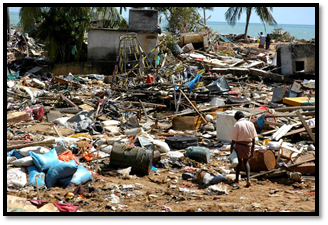
On December 26, 2004, an earthquake in the Indian Ocean resulted in a tsunami that killed over 200,000 people in at least a dozen different countries (Figure C.1; Editors of Encyclopedia Britannica 2018). In the aftermath, 30% of households in the United States donated an estimated $2.78 billion to help the victims (Center on Philanthropy at Indiana University 2008). At the same time, despite being one of the wealthiest countries in the world, the United States has over a million children who experience homelessness each year (National Center for Homeless Education 2017). Why is it that sometimes humans work together to help those in need, but at other times, humans struggle to solve basic problems? The field of Human Behavioral Ecology seeks to understand this and many other questions to learn why humans behave the way they do. Human Behavioral Ecology is the field of anthropology that explores how evolutionary history and ecological factors combine to influence human behavior.
Human Behavioral Ecology
Evolutionary History
Natural selection is the force of evolution by which individuals with heritable traits that result in greater survival and reproduction have more offspring than individuals without those traits. By having more offspring (specifically, offspring who themselves survive and reproduce), these heritable traits become more common in future generations. As an example, hominin brain size has increased dramatically over the past two million years. Our ancestors with larger brains were better able to survive and reproduce than those with smaller brains, possibly because they were better able to acquire food or navigate the social complexities of living in a large group (Dunbar 1998; Parker and Gibson 1979).
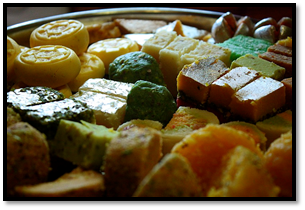
Human behavioral ecology uses the theory of evolution by natural selection to understand how modern behaviors were advantageous in our evolutionary history. For most of human history, humans lived as hunter-gatherers, meaning they collected or hunted food; they typically resided in small communities with individuals related through blood or marriage; and they had no access to modern medicines or other modern conveniences. It is useful to think about this environment—which is much different than how humans live today—to help us understand how current behaviors may have evolved. For example, humans today enjoy consuming food high in fats and sugars (Figure C.2; see Chapter 16). In the past, eating fatty and sugary food was a good survival strategy since food was limited in this environment and these foods contained a lot of calories. Over time, those individuals who sought out these foods were probably better able to survive and reproduce, resulting in a population of people today who have preferences for these foods. In modern environments, where food is abundant, this preference has likely contributed to the obesity epidemic, which increases people’s risk of cardiovascular diseases and no longer improves people’s ability to survive and reproduce.
Ecology
In addition to evolutionary history, the field of human behavioral ecology also focuses on the influence of ecology. Ecology is defined as one’s physical environment, including types of resources, predators, terrain, and weather, as well as one’s social environment, including the behaviors of other individuals and cultural rules. For example, if one lives in an environment where there are abundant fruit trees, then the diet likely includes fruit. Since fruits are easy to acquire, children can engage in food gathering at young ages. In contrast, in environments like the Arctic, where there are fewer plant resources, the diet focuses more on hunting and fishing. Since these skills take longer to acquire, children may only be able to contribute to their own subsistence at older ages. One’s environment influences the behaviors in which individuals engage, such as children’s foraging.
Another component of ecology is one’s social environment, including cultural rules. Throughout the world, different cultures have quite different norms of behavior. For instance, in some societies marriages are required to be monogamous, meaning that a marriage is between just two individuals. This is a cultural norm in the United States, and it is illegal to violate this rule. In other societies, marriages can occur between one man and several women or one woman and several men, referred to as polygyny and polyandry respectively. Across the world, polyandry tends to be quite rare, and in cultures with polyandrous marriage, polygynous and monogamous marriages also occur. The age difference of married people frequently depends on the type of marriages allowed in their culture. In cultures with polygynous marriage, the age difference between husbands and wives tends to be larger than it is in monogamous cultures, as the men who are able to attract additional wives tend to have high status or wealth and are typically older than the women who are available for marriage. In cultures with fraternal polyandry, defined as the marriage of one woman to a set of brothers, marriage typically occurs when the eldest brother is ready to marry and he typically marries a woman close in age. This results in the wife being older than some of her husbands, with the exception of the eldest one. The environment (both physical and social) influences one’s behavioral options, and human behavioral ecologists examine how one’s ecology influences people’s behavior. In Figure C.3, we see a visual depiction of the field of human behavioral ecology, using evolutionary history and ecology (physical environment plus culture) to explain modern human behavior.

Both Genes and Environment Influence Behavior
While physical characteristics (like height) are clearly heritable, we also know that they depend on the environment. When children grow up with poor nutrition and do not ingest enough calories, their growth is stunted. At the same time, if parents are both tall, then their child is more likely to be tall as well. Physical traits are the result of both genes and environment. Behavior is the same—dependent on both genes and environment. While there are no genes for specific behaviors, behavioral tendencies do show some level of heritability. Personality disorders, for instance, may be partially heritable, but it also depends on the environment in which a child is raised, where child neglect or sexual abuse may increase the risk of personality disorders (Johnson et al. 1999).
Human behavioral ecologists assume that even though there are not genes for specific behaviors, genes may influence behavioral tendencies. Additionally, behaviors are flexible and people use information from the environment to determine under which conditions they should behave in particular ways. For example, the ability to cooperate has evolved over evolutionary time, but whether or not an individual cooperates in a particular instance likely depends on the situation. Research shows that people are more likely to cooperate if: (1) their behavior is known to others (that is to say their identity is not anonymous); (2) it will improve their reputation; or (3) they will be punished for not cooperating (Andreoni and Petrie 2004; Fehr and Fischbacher 2003; Milinski, Semmann, and Krambeck 2002).
How Can Human Behavioral Ecology Help Us Understand Altruism?
Altruism is defined as providing a benefit to someone without expecting anything in return. A perfect example is donating money to tsunami victims. From an evolutionary perspective, it seems that providing benefits to others would be disadvantageous for one’s own survival and reproduction, as resources given to others are resources that cannot be used for oneself. But people do engage in altruistic behaviors, so how can the field of human behavioral ecology help us understand this behavior? We will use the example of food sharing to think about different ways that human behavioral ecologists have examined this question. In many small-scale hunter-gatherer societies, people share food extensively with other people living in their communities. This sharing is most widespread when the item is a hunted animal, which can typically feed many people. Just as giving away money seems counterintuitive, so does giving away food. So, why do people in these foraging communities share so much food with each other?
Kin Selection
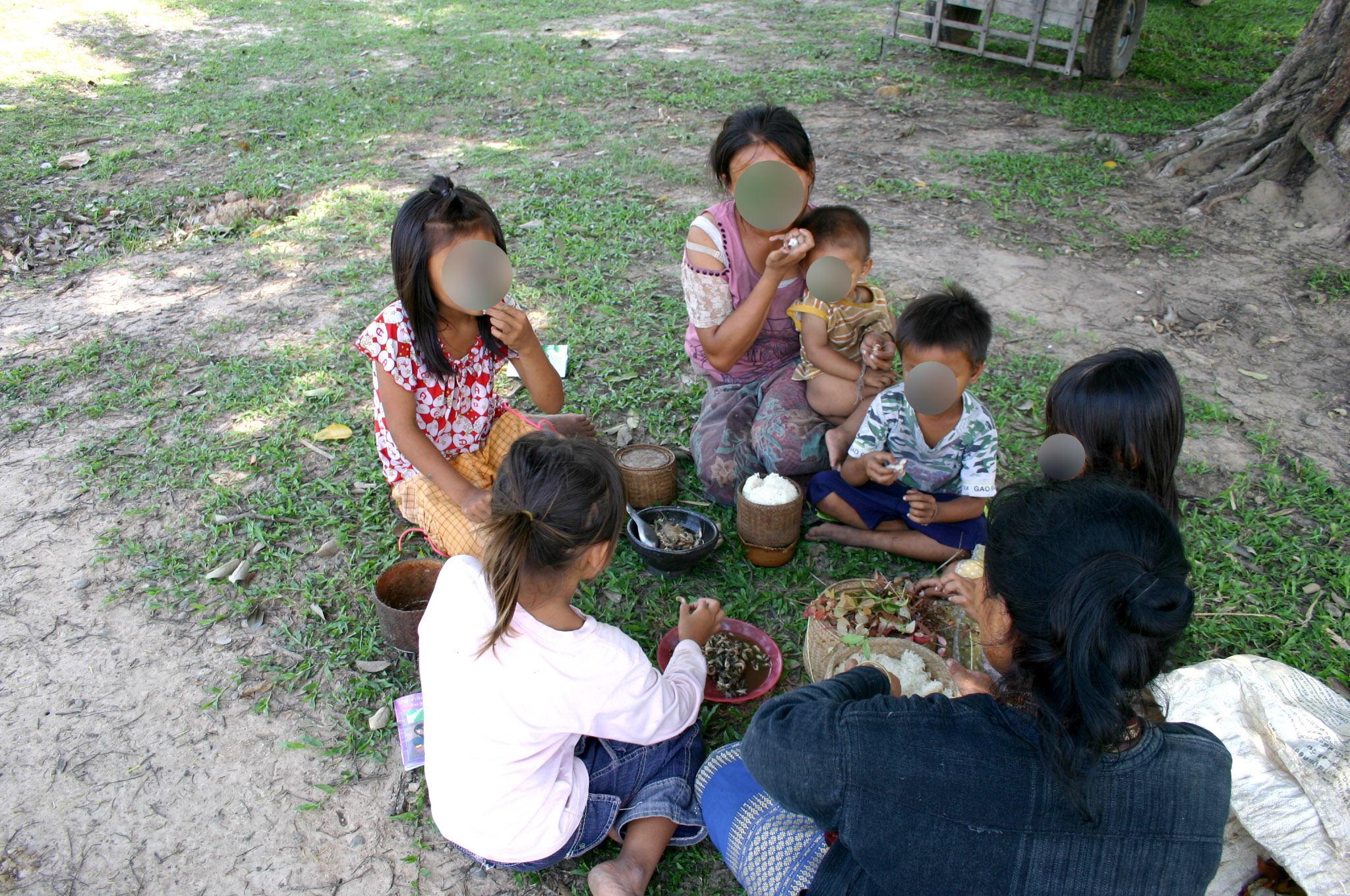
One of the first explanations for why humans share food is that they are sharing with their close family members. Kin selection proposes that individuals help kin, even at a cost to themselves, because this help is directed at individuals with whom they share genes. Genes that result in a person acting altruistically toward close kin would have become more frequent over time if individuals sharing that gene are more successful than those not sharing that gene (Hamilton 1964). Taking this perspective is described as a gene’s eye view. Since family members share genes, this may explain why kin help one another. Figure C.4 shows a Lao family eating together. It is very common around the world for families to share food with one another. In many small-scale societies, people share food with family members but also with those who are not family members. Kin selection helps explain some food sharing, but it doesn’t explain all food sharing.
Reciprocal Altruism
Another potential explanation for why humans share food is that they are engaging in reciprocal altruism, meaning that an individual shares food today with the expectation of repayment at some point in the future (Trivers 1971). This can work well, unless the person who receives the help chooses not to reciprocate in the future. In this case, the original sharer does not obtain anything in return. To maintain these relationships, it is important that individuals have the opportunity to share with one another repeatedly and that if one person chooses not to reciprocate, the original sharer terminates their sharing.
Reciprocal altruism is even more likely to occur if the value of the food is greater to the person receiving the food than the person sharing the food. For instance, imagine that you have an entire pizza. After you eat several slices, you are no longer hungry and the next piece of pizza has little value to you. In contrast, if you are hungry, receiving a slice of pizza from a friend would mean a lot to you. In this case, the person giving a piece of pizza after already eating their fill is giving away something of little value, but the person receiving a slice of pizza when they are hungry is receiving something with substantial value. If the following week the roles are reversed, then in both cases, the person receiving the food has received something of greater value than the person who gave it away.
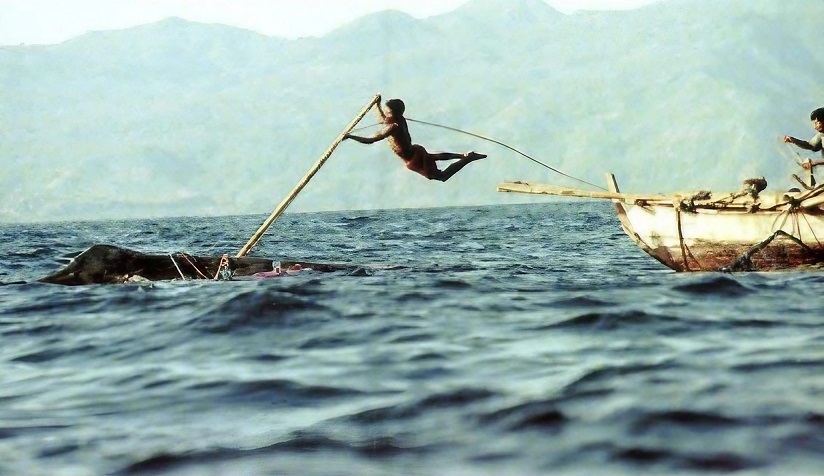
This makes sense in the case of sharing hunted meat as well. In environments without refrigeration technology or in highly mobile groups where food storage is not feasible, the killing of a large animal will result in leftover meat. Sharing that meat with hungry community members has a lot of value to those receiving the meat. Then, at some point in the future, the person who received the meat may successfully hunt and share with others. Figure C.5 displays an Indigenous hunting party from Malaysia. Food is widely shared in small-scale societies, particularly when the item is large in size and when there is a lot of uncertainty around when the next successful hunt will occur (Gurven 2004). But, as with other skilled activities, some individuals are better hunters than others and acquire more meat than others consistently, so why would highly skilled hunters give more food to low-skilled hunters than will be reciprocated (e.g., Gurven et al. 2000)? Again, reciprocal altruism is one piece of the story but cannot explain all sharing behavior.
Costly Signaling
Another possible explanation for why people share food, particularly meat in small-scale societies, is because they want to signal their foraging abilities and generosity (Smith and Bliege Bird 2000). One way to communicate to others your inherent qualities is to do something that is hard to fake. For instance, telling someone that you are a good hunter is not as convincing as hunting a difficult-to-acquire animal and sharing it with them. If someone is a poor hunter, it will be difficult for them to successfully hunt, so sharing hunted meat demonstrates one’s abilities. The hunter who provides resources to the community is likely viewed as generous, allowing them to attract mates, friends, and allies. Costly signaling theory argues that a signaller produces a costly display (e.g., shares hunted meat) to communicate honest information about themselves to others (e.g., I am a generous, skilled hunter). Costly signals can occur across species for a variety of purposes, but this example may help us understand why people share food with unrelated others who are unlikely to reciprocate.
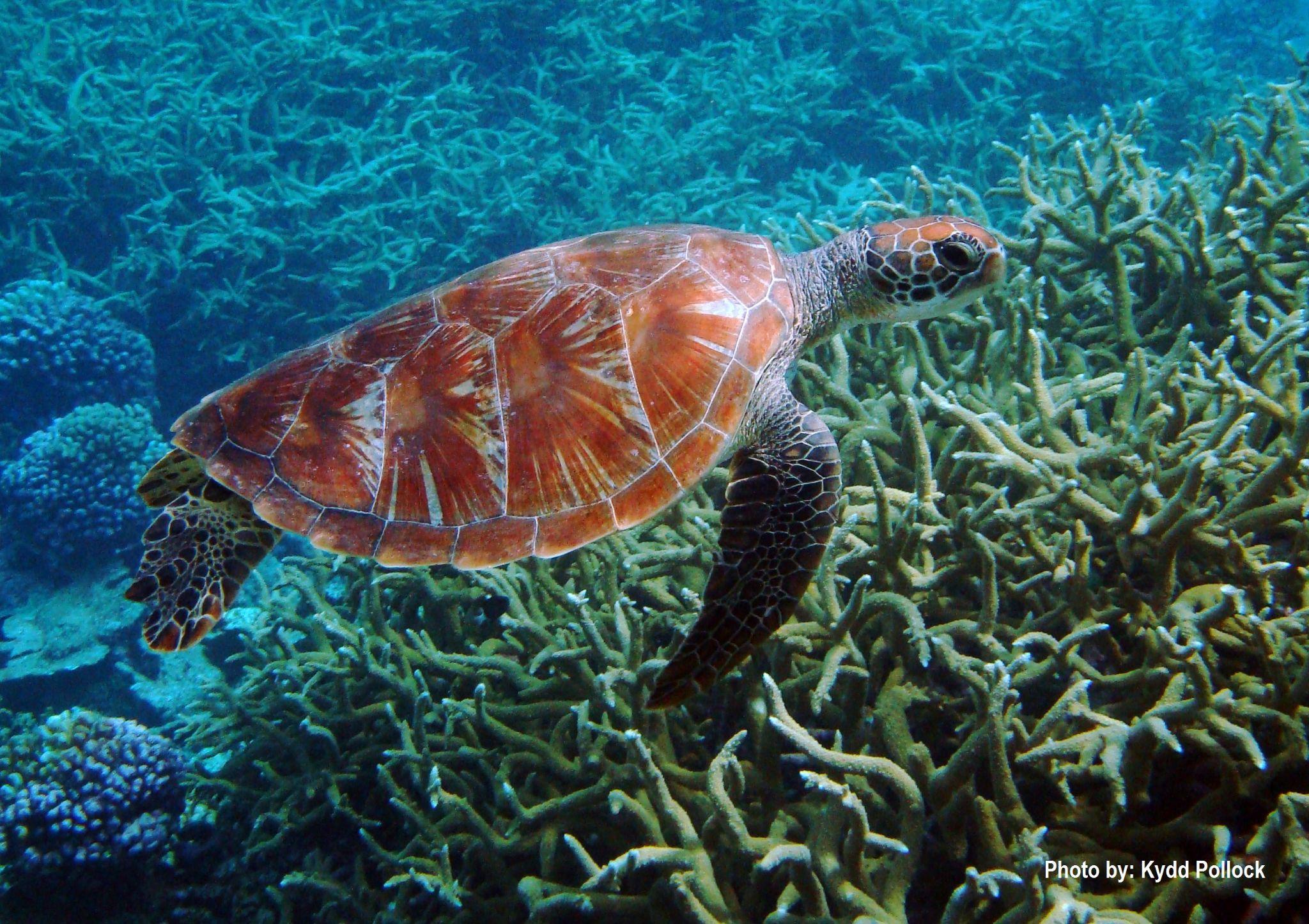
Among the Melanesian Meriam Islanders, turtles (Figure C.6) are hunted at two times of year; during the turtles’ feeding/mating season, which is risky and unpredictable, and during the turtles’ nesting season, which is low risk and relatively easier. Turtles hunted during the feeding/mating season are typically shared widely in the community, while turtles hunted during the nesting season are consumed by a small number of households. This suggests that more people know about high-risk hunts, which may result in hunters gaining more prestige for their successful hunts. Evidence also shows that hunters involved in high-risk hunting gain social and reproductive benefits, such as having children earlier and having more sexual (or reproductive) partners (Smith, Bliege Bird, and Bird 2003). While some sharing behavior may be best explained by a desire to display one’s skills to gain reputational benefits, it cannot explain all sharing behavior and likely works in conjunction with the other hypotheses described above.
What Does Food Sharing Tell Us about Altruism?
Examining these three explanations of sharing behavior—kin selection, reciprocal altruism, and costly signaling (Figure C.7)—helps explain a lot of sharing seen around the world, but donating money to tsunami victims is still hard to understand. Most donors from the United States were not related to the victims of the tsunami; donors probably did not expect reciprocation; and because the donors and receivers did not know each other, reputational benefits would have been limited to people who were made aware of the donation. While some charitable giving may be explained by the tax incentives, the donations to the tsunami victims were so extensive that it seems unlikely to be the main explanation. There are other hypotheses that have not been discussed here, but they also suffer from the inability to fully explain all examples of altruistic behavior. People commonly state that they donate because “it makes them feel good.” While helping others does make people feel good, this likely evolved because those that had the feel-good sensation helped others (like their family members) resulting in greater survival and reproduction. The “feel good” sensation is a proximate explanation, the immediate reason for the behavior, while human behavioral ecology seeks to understand the ultimate explanation, the deep evolutionary reason that this trait led to increased survival and reproduction. In the case of donating money to people living on the other side of the world, our modern environment (allowing us to help people living so far away) may lead us to act in ways that were adaptive in our evolutionary past but may not improve our survival or reproduction today.
Explanations of food sharing:
- Kin selection: Helping family members who share the same genes.
- Reciprocal altruism: Sharing food with someone with the expectation that they will reciprocate at some point in the future.
- Costly signaling: Providing food to others to display one’s foraging skill and generosity to improve one’s reputation or social standing.
At the same time, we struggle to solve the problem of homelessness across the United States. Using evolutionary theory may help us understand why people are unable to come together to eliminate this problem. Eradicating homelessness would be costly, would require the cooperation of lots of individuals (no single individual or small group can solve it on their own), and would be ongoing. This type of long-lasting commitment to help unrelated strangers may be difficult to acquire from large numbers of people.
How Can Human Behavioral Ecology Help Us Understand the World?
Throughout this appendix, I have been discussing one of the main research areas in Human Behavioral Ecology: cooperation and sharing. Two other prominent areas of research for Human Behavioral Ecologists include production and reproduction. Production research explores how people acquire the resources that they need. Some research in this area has examined which items people choose to include in their diets and how long people spend foraging. This research has shown that people do not simply acquire any food resource in their environment; instead they make strategic decisions based on the food options available and the possible nutrients gained. Research on reproduction includes an examination of how people choose mates, make reproductive choices, invest in children, and acquire help to raise offspring. This line of research has shown that human mothers need help from others to raise offspring, and this help can come from a variety of sources, including the child’s father, grandmothers, older siblings, grandfathers, or others (Hrdy 2009; Sear and Mace 2008). This is quite different from our nonhuman primate relatives, for whom almost all offspring care is given by mothers. These research areas capture many behaviors we faced in our evolutionary history: How did we obtain food, how did we distribute that food once we had it, and how did we make mating and reproductive decisions? All of the topics examined in the field of human behavioral ecology are closely linked to survival and reproduction and to understanding how the environment influences decision making.
Some common misperceptions about human behavioral ecology cause skepticism of this type of research. Some critiques have argued that studying the evolution of human behavior is problematic because of biological determinism, the idea that all behaviors are innate, determined by our genes. If behaviors are innate, then we cannot hold people accountable for their actions. But this is a misunderstanding. As mentioned previously, both genes and the environment influence behavior. Individuals may have a tendency to behave in a particular way, but behaviors are flexible. Also, there is no guarantee that everyone behaves in perfectly optimal ways. Over evolutionary time, those who behaved in ways that resulted in more successful offspring had a greater representation of genes in the next generation, but in each generation we have variation in environments, genotypes, phenotypes, and behaviors on which selection can act.
Another common misconception is that by studying human behavior, human behavioral ecologists are providing justifications for those behaviors. The naturalistic fallacy describes the incorrect belief that what occurs in nature is what ought to be. This is a fallacy because it is absolutely not the goal of researchers in this field. For instance, some researchers study human violence. It is wrong to assume that by studying violence, the researchers believe that violence is an acceptable behavior or is justifiable. It is easy to slip into this misconception.
Modern Applications
While it may seem that the field of human behavioral ecology is more concerned about our evolutionary past than our present, there are many contemporary issues that human behavioral ecology can help us solve. One area that human behavioral ecologists have focused on is climate change (Schradin 2021). In many ways, solving the climate crisis is similar to that of homelessness; it requires many people to come together and sacrifice for the benefit of all. Evidence has shown that people are more likely to sacrifice for others’ benefit when their good deeds are known, their actions improve their reputation, or their failure to act produces negative consequences, like increased taxes (Milinski et al. 2002). By focusing on these motivators, policy makers may be able to leverage people to minimize their carbon usage, although current progress achieving targets has seen limited success. Researchers have also used evolutionary theory to improve handwashing rates around the world (Curtis 2013), reduce the obesity epidemic (Pepper and Nettle 2014), ease conflicts (de Waal 2000), and improve cooperation (Boyd and Richerson 1992).
Special Topic: Fertility Research in Human Behavioral Ecology
To understand how human behavior has evolved through time and responds to local environments, human behavioral ecologists collect data on populations across the world. Globally, people are choosing to have fewer children than in the past. Some countries are still dealing with overpopulation, but an even larger number are dealing with population aging and fear of depopulation. Understanding decisions about how many children to have is important in today’s world and is the focus of my research. To examine how family size is changing, researchers calculate total fertility rate, which is specific to a given year and is calculated as the total number of children that would be born to a female if she were to give birth at that particular year’s age-specific fertility rate for each age. This is a value that represents the fertility of females at all ages in a particular year but does not represent any particular person (since a real person experiences fertility across many years). I conducted fieldwork in rural Bolivia, a place where the total fertility rate was approximately 6 children per woman in 1970 but fell to only 3 children per woman by 2013 (World Bank 2022). By interviewing people who live in communities that are undergoing rapid changes in fertility rates, I attempt to understand how people make decisions about family size.
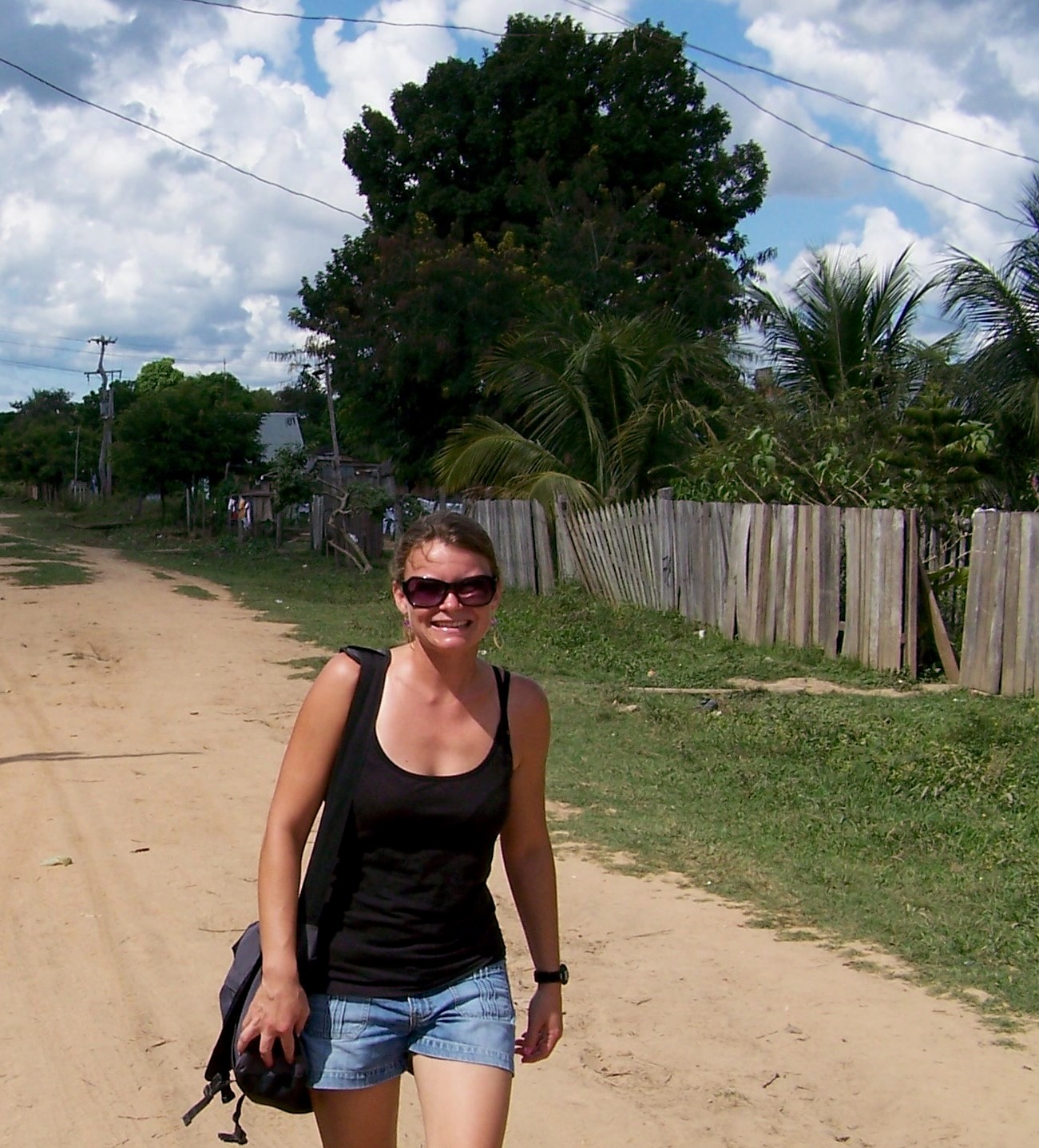
Figure C.8 shows me walking from house to house during my fieldwork in Bolivia. My interviews with over 500 Bolivian women found that those who had more education or those who expected their children to go further in school had fewer children and that family size was similar across groups of friends (Snopkowski and Kaplan 2014). While the conflict between work and childcare is particularly difficult for parents in postindustrialized contexts, in this rural Bolivian community, most women were able to integrate their daily work with childcare. For instance, a woman may own a shop where she could engage in childcare and run the shop simultaneously. To fully understand human behavior cross-culturally, we need to examine many different societies. Using large datasets collected in 45 different countries, my collaborator and I were able to examine how factors such as education and wealth may have different effects on fertility across the world (Colleran and Snopkowski 2018). Our results showed that in every country surveyed, more education for women was associated with having fewer children, but the effect of wealth varied. In countries with high fertility, more wealth typically associated with more children, but in countries with low fertility, more wealth was typically associated with fewer children. These results show that as people have access to more education and choose to educate themselves and their children, small families will become the norm everywhere in the world.
Review Questions
- In human behavioral ecology, human behavior is the result of the interaction among which two factors?
- What are the three main explanations for why people in small-scale societies share food extensively?
- Describe the difference between a proximate and an ultimate explanation and include an example of each.
- What are two misconceptions about human behavioral ecology?
- What contemporary world issues can human behavioral ecology help us solve?
Key Terms
Altruism: Providing a benefit to someone else at a cost to oneself, without expecting future reciprocation.
Biological determinism: The idea that behaviors are determined exclusively by genes.
Costly signaling theory: A theory by which individuals provide honest signals about personal attributes through costly displays.
Ecology: The physical and social environment, including food resources, predators, terrain, weather, social rules, behavior of other people, and cultural rules.
Evolutionary history: An understanding of how traits (including behaviors) may be the result of natural selection in our hominin past.
Human Behavioral Ecology: The field of anthropology that explores how ecological factors and evolutionary history combine to influence how humans behave.
Kin selection: A type of natural selection whereby people help relatives, which can evolve because people are helping other individuals with whom they share genes.
Naturalistic fallacy: The incorrect belief that what occurs is what ought to be.
Population aging: An increase in the number and proportion of people who are over the age of 60.
Proximate explanation: The mechanism that is immediately responsible for an event.
Reciprocal altruism: Helping behavior that occurs because individuals expect that any help they provide will be reciprocated in the future.
Total fertility rate: the number of children a hypothetical female would have at the end of their reproductive period if they experienced fertility rates of a given year for each year of their reproductive period and were not subject to mortality. It represents the fertility of all females in a given year. It is reported as children per woman.
Ultimate explanation: An explanation for an event that is further removed than a proximate explanation but provides a greater insight or understanding. In human behavioral ecology, ultimate explanations usually describe how a behavior is linked to reproduction and survival.
About the Author
Kristin Snopkowski, Ph.D.
Boise State University, kristinsnopkowski@boisestate.edu
Kristin Snopkowski is Associate Professor of Anthropology at Boise State University specializing in human behavioral ecology. Her research examines reproductive decisions, including how many children people have, how other family members influence fertility decisions, and the interaction between females and males in negotiating these decisions. She has conducted field work in Bolivia and Peru, interviewing women about their reproductive choices, and has been analyzing data sets from around the world to understand how environmental factors influence these decisions worldwide. She has published more than 15 peer-reviewed journal articles and co-edited the special issue The Behavioral Ecology of the Family.
For Further Exploration
Barrett, Louise, Robin Dunbar, and John Lycett. 2002. Human Evolutionary Psychology. Princeton: Princeton University Press.
Cronk, Lee, and Beth L. Leech. 2013. Meeting at Grand Central: Understanding the Social and Evolutionary Roots of Cooperation. Princeton: Princeton University Press.
Low, Bobbi S. 2015. Why Sex Matters: A Darwinian Look at Human Behavior. Princeton: Princeton University Press.
Raihani, Nichola. 2021. The Social Instinct: How Cooperation Shaped the World. New York: St. Martin’s Press.
REFERENCES
Andreoni, James, and Ragan Petrie. 2004. “Public Goods Experiments without Confidentiality: A Glimpse into Fund-Raising.” Journal of Public Economics 88 (7-8): 1605–1623. https://doi.org/10.1016/S0047-2727(03)00040-9.
Boyd, Robert, and Peter J. Richerson. 1992. “Punishment Allows the Evolution of Cooperation (or Anything Else) in Sizable Groups.” Ethology and Sociobiology 13 (3): 171–195. Center on Philanthropy at Indiana University. 2008. “Key Findings about Charitable Giving.” Accessed June 26, 2023. https://scholarworks.iupui.edu/bitstream/handle/1805/5775/copps_2005_key_findings.pdf?sequence=1&isAllowed=y.
Colleran, Heidi, and Kristin Snopkowski. 2018. “Variation in Wealth and Educational Drivers of Fertility Decline across 45 Countries.” Population Ecology 60: 155–169. https://doi.org/10.1007/s10144-018-0626-5.
Curtis, Valerie. 2013. Don’t Look, Don’t Touch, Don’t Eat. Chicago: University of Chicago Press.
de Waal, Frans B. M. 2000. “Primates—A Natural Heritage of Conflict Resolution.” Science 289 (5479): 586–590. https://doi.org/10.1126/science.289.5479.586.
Dunbar, Robin I. M. 1998. “The Social Brain Hypothesis.” Evolutionary Anthropology 6 (5): 178–190.
Editors of Encyclopaedia Britannica. 2018. “Indian Ocean Tsunami of 2004.” Encyclopaedia Britannica. Accessed June 26, 2023. https://www.britannica.com/event/Indian-Ocean-tsunami-of-2004.
Fehr, Ernst, and Urs Fischbacher. 2003. “The Nature of Human Altruism.” Nature 425: 785–791.
Gurven, Michael. 2004. “Reciprocal Altruism and Food-Sharing Decisions among Hiwi and Ache Hunter-Gatherers.” Behavioral Ecology and Sociobiology 56 (4): 366–380. https://doi.org/10.1007/s00265-004-0793-6.
Gurven, Michael, Wesley Allen-Arave, Kim Hill, and Magdalena Hurtado. 2000. “‘It’s a Wonderful Life’: Signaling Generosity among the Ache of Paraguay.” Evolution and Human Behavior 21 (4): 263–282.
Hamilton, W. D. 1964. “The Genetical Evolution of Social Behaviour I & II.” Journal of Theoretical Biology 7 (1): 1–52.
Hrdy, Sarah Blaffer. 2009. Mothers and Others: The Evolutionary Origins of Mutual Understanding. Cambridge, MA: The Belknap Press of Harvard University Press.
Johnson, Jeffrey G., Patricia Cohen, Jocelyn Brown, Elizabeth M. Smailes, and David P. Bernstein. 1999. “Childhood Maltreatment Increases Risk for Personality Disorders during Early Adulthood.” Archives of General Psychiatry 56 (7): 600–606. https://doi.org/10.1001/archpsyc.56.7.600.
Milinski, Manfred, Dirk Semmann, and Hans-Jürgen Krambeck. 2002. “Reputation Helps Solve the ‘Tragedy of the Commons.’” Nature 415: 424–426.
National Center for Homeless Education. 2017. “Federal Data Summary: School Years 2013–2014 to 2015–2016.” Accessed June 26, 2023. https://nche.ed.gov/wp-content/uploads/2018/11/data-comp-1314-1516.pdf.
Parker, Sue Taylor, and Kathleen Rita Gibson. 1979. “A Developmental Model for the Evolution of Language and Intelligence in Early Hominids.” Behavioral and Brain Sciences 2 (3): 367–381. https://doi.org/10.1017/S0140525X0006307X.
Pepper, Gillian V., and Daniel Nettle. 2014. “Out-of-Control Mortality Matters: The Effect of Perceived Uncontrollable Mortality Risk on a Health-Related Decision.” PeerJ 2: e459. https://doi.org/10.7717/peerj.459.
Schradin, Carsten. 2021. “Corona, Climate Change, and Evolved Human Behavior” Trends in Ecology & Evolution 36 (7): 569-572.
Sear, Rebecca, and Ruth Mace. 2008. “Who Keeps Children Alive? A Review of the Effects of Kin on Child Survival.” Evolution and Human Behavior 29 (1): 1–18. https://doi.org/10.1016/j.evolhumbehav.2007.10.001.
Smith, Eric Alden, and Rebecca L. Bliege Bird. 2000. “Turtle Hunting and Tombstone Opening: Public Generosity as Costly Signaling.” Evolution and Human Behavior 21 (4): 245–261. https://doi.org/10.1016/S1090-5138(00)00031-3.
Smith, Eric Alden, Rebecca Bliege Bird, and Douglas W. Bird. 2003. “The Benefits of Costly Signaling: Meriam Turtle Hunters.” Behavioral Ecology 14 (1): 116–126. https://doi.org/10.1093/beheco/14.1.116.
Snopkowski, Kristin, and Hillard Kaplan. 2014. “A Synthetic Biosocial Model of Fertility Transition: Testing the Relative Contribution of Embodied Capital Theory, Changing Cultural Norms, and Women’s Labor Force Participation.” American Journal of Physical Anthropology 154 (3): 322–333. https://doi.org/10.1002/ajpa.22512.
Trivers, Robert L. 1971. “The Evolution of Reciprocal Altruism.” The Quarterly Review of Biology 46 (1): 35–57. https://doi.org/10.1086/406755.
World Bank. 2022. “Fertility Rate, Total (Births per Woman): Bolivia.” The World Bank Group. Accessed November 15, 2022. https://data.worldbank.org/indicator/SP.DYN.TFRT.IN?locations=BO.
The field of anthropology that explores how ecological factors and evolutionary history combine to influence how humans behave.
An understanding of how traits (including behaviors) may be the result of natural selection in our hominin past.
The relationship between organisms and their physical surroundings.
Providing a benefit to someone else at a cost to oneself, without expecting future reciprocation.
A type of natural selection whereby people help relatives, which can evolve because people are helping other individuals with whom they share genes.
Helping behavior that occurs because individuals expect that any help they provide will be reciprocated in the future.
A theory by which individuals provide honest signals about personal attributes through costly displays.
The mechanism that is immediately responsible for an event.
An explanation for an event that is further removed than a proximate explanation but provides a greater insight or understanding. In human behavioral ecology, ultimate explanations usually describe how a behavior is linked to reproduction and survival.
The idea that behaviors are determined exclusively by genes.
The incorrect belief that what occurs is what ought to be.
An increase in the number and proportion of people who are over the age of 60.
the number of children a hypothetical female would have at the end of their reproductive period if they experienced fertility rates of a given year for each year of their reproductive period and were not subject to mortality. It represents the fertility of all females in a given year. It is reported as children per woman.

